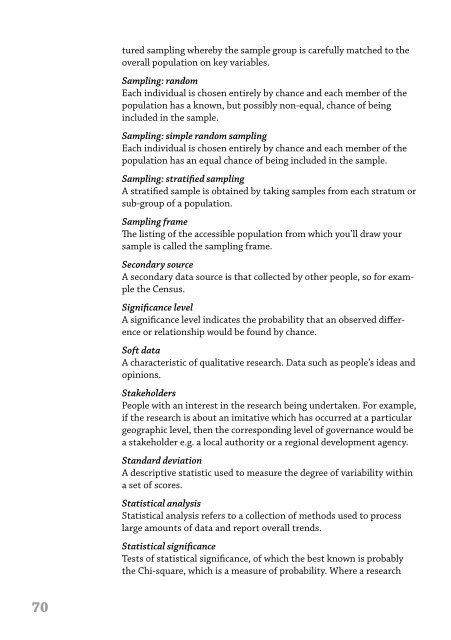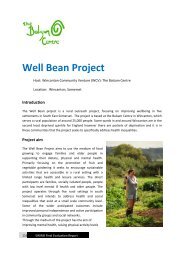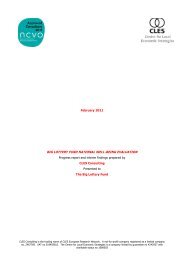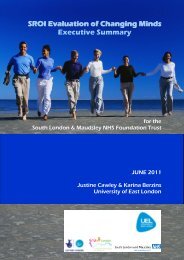Research Methods Handbook.pdf - CLES
Research Methods Handbook.pdf - CLES
Research Methods Handbook.pdf - CLES
You also want an ePaper? Increase the reach of your titles
YUMPU automatically turns print PDFs into web optimized ePapers that Google loves.
tured sampling whereby the sample group is carefully matched to theoverall population on key variables.Sampling: randomEach individual is chosen entirely by chance and each member of thepopulation has a known, but possibly non-equal, chance of beingincluded in the sample.Sampling: simple random samplingEach individual is chosen entirely by chance and each member of thepopulation has an equal chance of being included in the sample.Sampling: stratified samplingA stratified sample is obtained by taking samples from each stratum orsub-group of a population.Sampling frameThe listing of the accessible population from which you’ll draw yoursample is called the sampling frame.Secondary sourceA secondary data source is that collected by other people, so for examplethe Census.Significance levelA significance level indicates the probability that an observed differenceor relationship would be found by chance.Soft dataA characteristic of qualitative research. Data such as people’s ideas andopinions.StakeholdersPeople with an interest in the research being undertaken. For example,if the research is about an imitative which has occurred at a particulargeographic level, then the corresponding level of governance would bea stakeholder e.g. a local authority or a regional development agency.Standard deviationA descriptive statistic used to measure the degree of variability withina set of scores.Statistical analysisStatistical analysis refers to a collection of methods used to processlarge amounts of data and report overall trends.Statistical significanceTests of statistical significance, of which the best known is probablythe Chi-square, which is a measure of probability. Where a researchTUsample has been used, it is important to know, whether the findings arevalid or came about by chance.Statistical testsSee section on statistical analysis for a description of the most commonstatistical tests.Survey designSurvey design covers the definition of all aspects of a survey from theestablishment of a need for data to the production of final outputs.TabulationsA set of data, which provides a count of the number of occasions onwhich a particular answer/response has been given across all of thoserespondents who tackled the question.Textual analysisUsed in analysis of secondary source data and also in qualitativeresearch. It involves working on a text in depth, looking for keywordsand concepts and making links between them. The term also extends toliterature reviewing. Increasingly, much textual analysis is done usingcomputer programs such as NVivo, ATLAS.ti, NU*DIST.Trend studiesTrend studies establish a pattern over time to detect shifts and changesand are valuable in describing long-term changes in a population.TriangulationA multi-method approach, using different methods in order to focus onthe research topic from different viewpoints and to produce a multifacetedset of data. Also used to check the validity of findings from anyone method.Type I ErrorRejecting the null hypothesis when it is true.Type II ErrorAccepting the null hypothesis when it is false.UniverseThe term universe is used to denote whatever body of people is beingstudied.70 71









